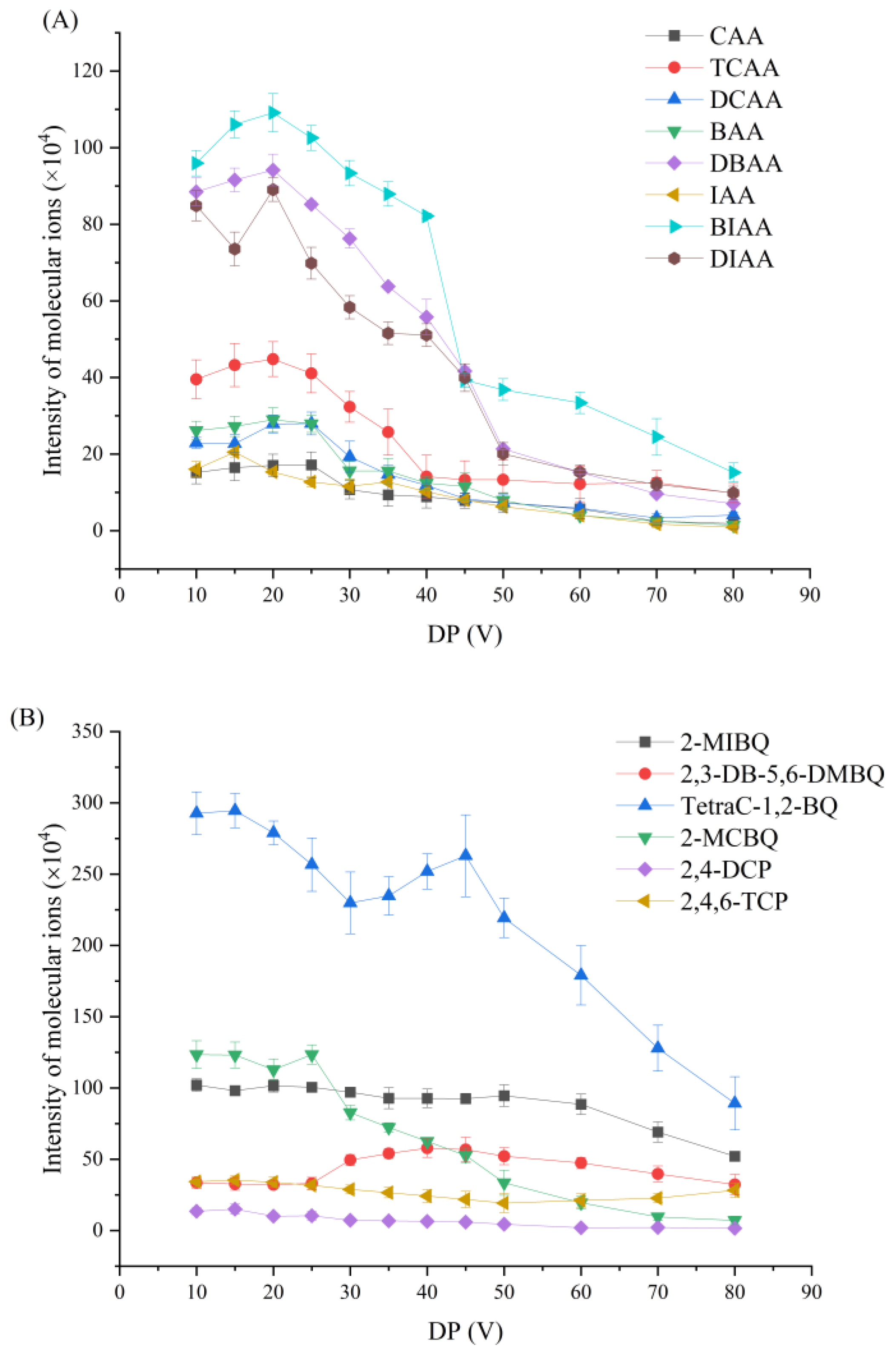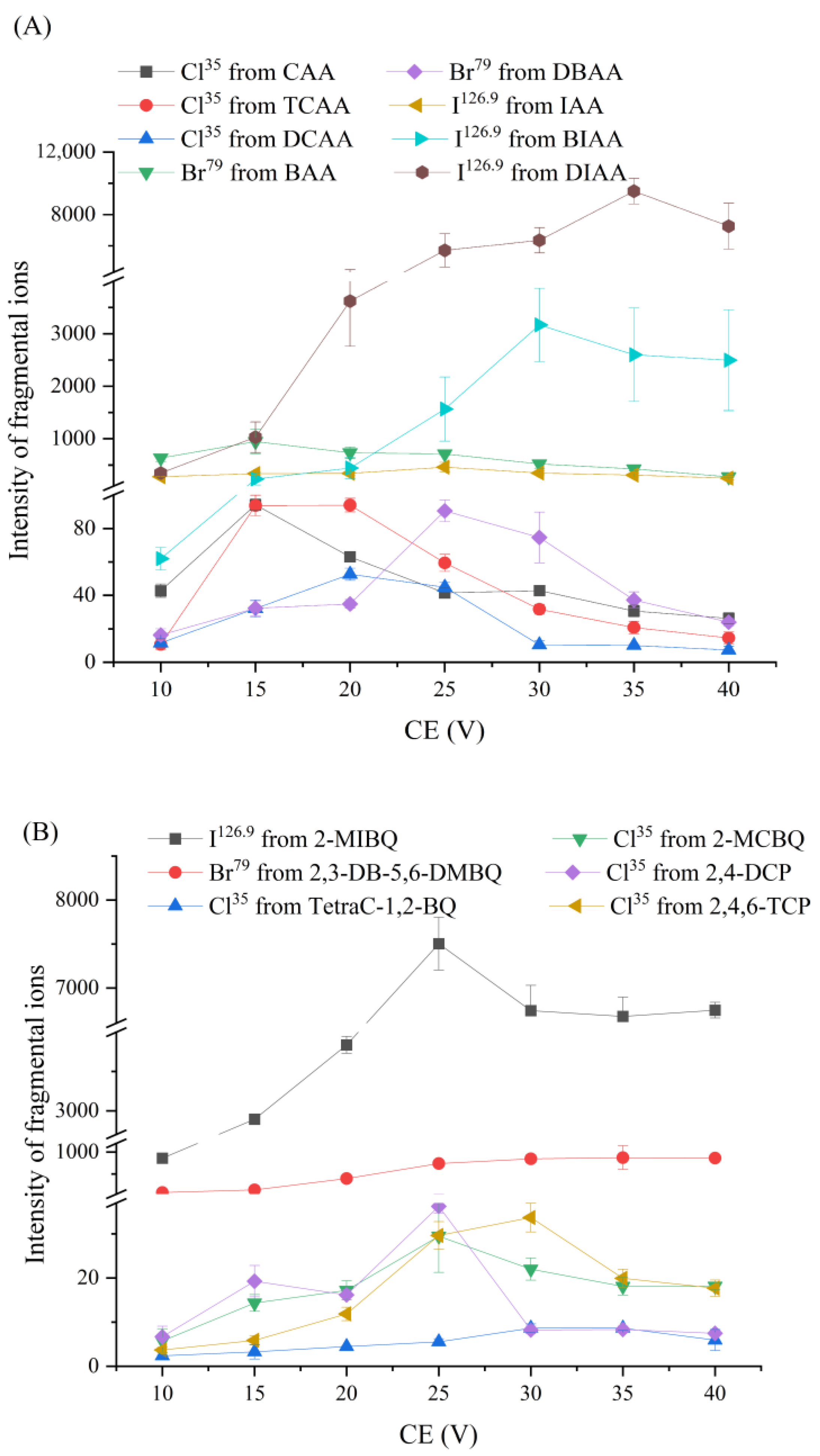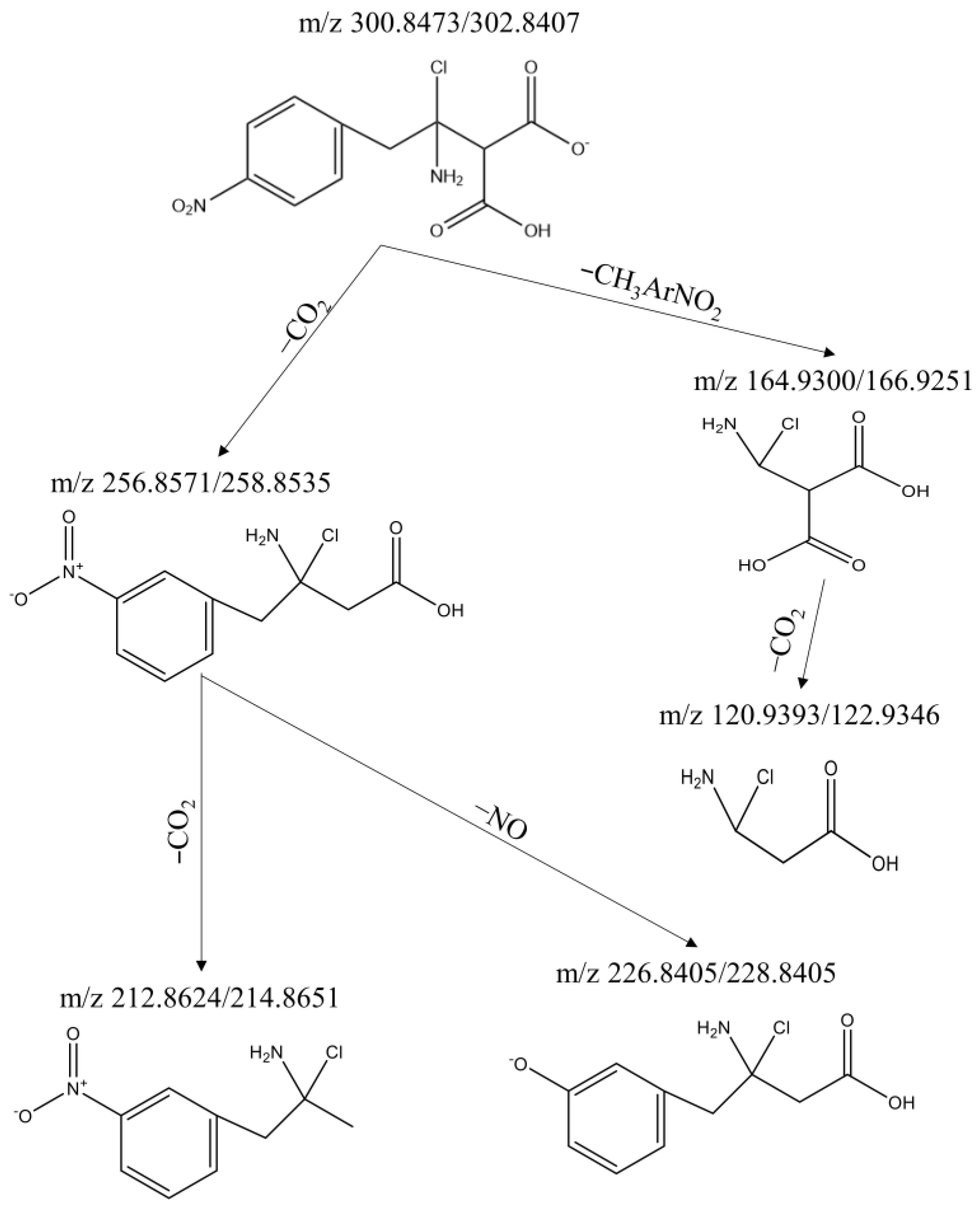The Selectively Nontargeted Analysis of Halogenated Disinfection Byproducts in Tap Water by Micro-LC QTOFMS
Abstract
:1. Introduction
2. Materials and Methods
2.1. Chemicals, Reagents, and Materials
2.2. Sample Collection and Pretreatment
2.3. Instrumental Method
3. Results and Discussion
3.1. Optimization of MS Parameters with Model DBPs
3.2. Detection of Halogenated DBPs in Tap Water with SNTA Method
4. Conclusions
Supplementary Materials
Author Contributions
Funding
Data Availability Statement
Conflicts of Interest
References
- Tan, J.; Allard, S.; Gruchlik, Y.; Mcdonald, S.; Joll, C.A.; Heitz, A. Impact of bromide on halogen incorporation into organic moieties in chlorinated drinking water treatment and distribution systems. Sci. Total Environ. 2016, 541, 1572–1580. [Google Scholar] [CrossRef] [PubMed]
- Yang, X.Q.; Zheng, Q.; He, M.; Chen, B.B.; Hu, B. Bromine and iodine species in drinking water supply system along the Changjiang River in China: Occurrence and transformation. Water Res. 2021, 202, 117401. [Google Scholar] [CrossRef]
- Zhu, X.H.; Zhang, X.R. Modeling the formation of TOCl, TOBr and TOI during chlor(am)ination of drinking water. Water Res. 2016, 96, 166–176. [Google Scholar] [CrossRef] [PubMed]
- Guermazi, D.; Rovira, A.; Barrat, J.A.; Tripier, R.; Ben Salem, D. Iodinated disinfection byproducts: A silent threat, why should we care? J. Neuroradiol. 2024, 51, 290–291. [Google Scholar] [CrossRef]
- Chen, H.; Xie, J.; Huang, C.; Liang, Y.; Zhang, Y.; Zhao, X.; Ling, Y.; Wang, L.; Zheng, Q.; Yang, X. Database and review of disinfection by-products since 1974: Constituent elements, molecular weights, and structures. J. Hazard. Mater. 2024, 462, 132792. [Google Scholar] [CrossRef]
- Liberatore, H.K.; Plewa, M.J.; Wagner, E.D.; VanBriesen, J.M.; Burnett, D.B.; Cizmas, L.H.; Richardson, S.D. Identification and Comparative Mammalian Cell Cytotoxicity of New lodo-Phenolic Disinfection Byproducts in Chloraminated Oil and Gas Wastewaters. Environ. Sci. Technol. Lett. 2017, 4, 475–480. [Google Scholar] [CrossRef]
- Plewa, M.J.; Simmons, J.E.; Richardson, S.D.; Wagner, E.D. Mammalian Cell Cytotoxicity and Genotoxicity of the Haloacetic Acids, A Major Class of Drinking Water Disinfection By-Products. Environ. Mol. Mutagen. 2010, 51, 871–878. [Google Scholar] [CrossRef] [PubMed]
- Li, J.H.; Wang, W.; Moe, B.; Wang, H.L.; Li, X.F. Chemical and Toxicological Characterization of Halobenzoquinones, an Emerging Class of Disinfection Byproducts. Chem. Res. Toxicol. 2015, 28, 306–318. [Google Scholar] [CrossRef]
- Li, J.B.; Zhang, H.F.; Wang, J.; Yu, Z.Y.; Li, H.Y.; Yang, M. Identification of unknown disinfection byproducts in drinking water produced from Taihu Lake source water. J. Environ. Sci. 2022, 113, 1–11. [Google Scholar] [CrossRef] [PubMed]
- Chen, Y.; Zou, M.; Huang, Y.; Xie, Z.Y.; Liu, H.Z.; Wu, Q.; Jiao, W.M.; Qiu, J.L.; Huang, G.; Yang, X. Advances of mass spectrometry in characterization of disinfection byproducts in drinking water. TrAC Trends Anal. Chem. 2023, 166, 117209. [Google Scholar] [CrossRef]
- Li, C.M.; Wang, D.H.; Li, N.; Luo, Q.; Xu, X.; Wang, Z.J. Identifying unknown by-products in drinking water using comprehensive two-dimensional gas chromatography-quadrupole mass spectrometry and in silico toxicity assessment. Chemosphere 2016, 163, 535–543. [Google Scholar] [CrossRef] [PubMed]
- Lu, Y.; Song, Z.M.; Wang, C.; Liang, J.K.; Hu, Q.; Wu, Q.Y. Nontargeted identification of chlorinated disinfection byproducts formed from natural organic matter using Orbitrap mass spectrometry and a halogen extraction code. J. Hazard. Mater. 2021, 416, 126198. [Google Scholar] [CrossRef] [PubMed]
- Yang, X.Q.; Wang, C.; Shao, H.C.; Zheng, Q. Non-targeted screening and analysis of volatile organic compounds in drinking water by DLLME with GC-MS. Sci. Total Environ. 2019, 694, 133494. [Google Scholar] [CrossRef]
- Tang, Y.N.; Xu, Y.; Li, F.; Jmaiff, L.; Hrudey, S.E.; Li, X.F. Nontargeted identification of peptides and disinfection byproducts in water. J. Environ. Sci. 2016, 42, 259–266. [Google Scholar] [CrossRef] [PubMed]
- Zhang, X.R.; Talley, J.W.; Boggess, B.; Ding, G.Y.; Birdsell, D. Fast selective detection of polar brominated disinfection byproducts in drinking water using precursor ion scans. Environ. Sci. Technol. 2008, 42, 6598–6603. [Google Scholar] [CrossRef] [PubMed]
- Ding, G.Y.; Zhang, X.R. A Picture of Polar Iodinated Disinfection Byproducts in Drinking Water by (UPLC/)ESI-tqMS. Environ. Sci. Technol. 2009, 43, 9287–9293. [Google Scholar] [CrossRef] [PubMed]
- Zhai, H.Y.; Zhang, X.R. Formation and Decomposition of New and Unknown Polar Brominated Disinfection Byproducts during Chlorination. Environ. Sci. Technol. 2011, 45, 2194–2201. [Google Scholar] [CrossRef]
- Ding, G.Y.; Zhang, X.R.; Yang, M.T.; Pan, Y. Formation of new brominated disinfection byproducts during chlorination of saline sewage effluents. Water Res. 2013, 47, 2710–2718. [Google Scholar] [CrossRef]
- Pan, Y.; Zhang, X.R. Four groups of new aromatic halogenated disinfection byproducts: Effect of bromide concentration on their formation and speciation in chlorinated drinking Water. Environ. Sci. Technol. 2013, 47, 1265–1273. [Google Scholar] [CrossRef]
- Yang, M.T.; Zhang, X.R.; Liang, Q.H.; Yang, B. Application of (LC/)MS/MS precursor ion scan for evaluating the occurrence, formation and control of polar halogenated DBPs in disinfected waters: A review. Water Res. 2019, 158, 322–337. [Google Scholar] [CrossRef]
- Hwang, C.J.; Sclimenti, M.J.; Krasner, S.W. Disinfection By-Product Formation Reactivities of Natural Organic Matter Fractions of a Low-Humic Water. In Natural Organic Matter and Disinfection By-Products; American Chemical Society: Washington, DC, USA, 2000; Volume 761, pp. 173–187. [Google Scholar]
- Edwards, M. Predicting DOC removal during enhanced coagulation. J. AWWA 1997, 89, 78–89. [Google Scholar] [CrossRef]
- Barrett, S.E.; Krasner, S.W.; Amy, G.L. Natural Organic Matter and Disinfection By-Products: Characterization and Control in Drinking Water—An Overview. In Natural Organic Matter and Disinfection By-Products; American Chemical Society: Washington, DC, USA, 2000; Volume 761, pp. 2–14. [Google Scholar]
- Jiang, J.; Han, J.; Zhang, X. Nonhalogenated Aromatic DBPs in Drinking Water Chlorination: A Gap between NOM and Halogenated Aromatic DBPs. Environ. Sci. Technol. 2020, 54, 1646–1656. [Google Scholar] [CrossRef]
- Richardson, S.D. Disinfection by-products: Formation and occurrence in drinking Water. In Encyclopedia of Environmental Health; Nriagu, J.O., Ed.; Elsevier: Burlington, MA, USA, 2011; pp. 110–136. [Google Scholar]
- Wang, W.; Moe, B.; Li, J.H.; Qian, Y.C.; Zheng, Q.; Li, X.F. Analytical characterization, occurrence, transformation, and removal of the emerging disinfection byproducts halobenzoquinones in water. TrAC Trends Anal. Chem. 2016, 85, 97–110. [Google Scholar] [CrossRef]
- Postigo, C.; Andersson, A.; Harir, M.; Bastviken, D.; Gonsior, M.; Schmitt-Kopplin, P.; Gago-Ferrero, P.; Ahrens, L.; Ahrens, L.; Wiberg, K. Unraveling the chemodiversity of halogenated disinfection by-products formed during drinking water treatment using target and non-target screening tools. J. Hazard. Mater. 2021, 401, 123681. [Google Scholar] [CrossRef] [PubMed]
- Lu, Y.; Song, Z.-M.; Wang, C.; Liang, J.-K.; Hu, Q.; Wu, Q.-Y. Combining high resolution mass spectrometry with a halogen extraction code to characterize and identify brominated disinfection byproducts formed during ozonation. Sci. Total Environ. 2021, 796, 149016. [Google Scholar] [CrossRef] [PubMed]
- Liu, X.; Liu, R.; Zhu, B.; Ruan, T.; Jiang, G. Characterization of Carbonyl Disinfection By-Products During Ozonation, Chlorination, and Chloramination of Dissolved Organic Matters. Environ. Sci. Technol. 2020, 54, 2218–2227. [Google Scholar] [CrossRef]
- Lavonen, E.E.; Gonsior, M.; Tranvik, L.J.; Schmitt-Kopplin, P.; Kohler, S.J. Selective Chlorination of Natural Organic Matter: Identification of Previously Unknown Disinfection Byproducts. Environ. Sci. Technol. 2013, 47, 2264–2271. [Google Scholar] [CrossRef]
- Bulloch, D.N.; Nelson, E.D.; Carr, S.A.; Wissman, C.R.; Armstrong, J.L.; Schlenk, D.; Larive, C.K. Occurrence of Halogenated Transformation Products of Selected Pharmaceuticals and Personal Care Products in Secondary and Tertiary Treated Wastewaters from Southern California. Environ. Sci. Technol. 2015, 49, 2044–2051. [Google Scholar] [CrossRef]
- Liu, J.; Zhang, X.; Li, Y. Photoconversion of Chlorinated Saline Wastewater DBPs in Receiving Seawater is Overall a Detoxification Process. Environ. Sci. Technol. 2017, 51, 58–67. [Google Scholar] [CrossRef] [PubMed]
- Taguchi, V.Y. Structural elucidation of disinfection by-products in treated drinking water. Rapid Commun. Mass Spectrom. 2001, 15, 455–461. [Google Scholar] [CrossRef] [PubMed]
- Craven, C.B.; Tang, Y.A.; Carroll, K.; An, L.R.; Chen, B.; Li, X.F. Closing the gap of known and unknown halogenated nitrogenous disinfection byproducts in water: Advanced mass spectrometry techniques. TrAC Trends Anal. Chem. 2022, 153, 116624. [Google Scholar] [CrossRef]
- Plewa, M.J.; Wagner, E.D.; Richardson, S.D. TIC-Tox: A preliminary discussion on identifying the forcing agents of DBP-mediated toxicity of disinfected water. J. Environ. Sci. 2017, 58, 208–216. [Google Scholar] [CrossRef] [PubMed]



| (M-H)− | (M-H+2)− | (M-H+4)− | (M-H+6)− | Ratio | (M-H-CO2)− | (M-H-HX)− | RT (min) | |
|---|---|---|---|---|---|---|---|---|
| CAA | 92.9757 | 94.9800 | 3:1 | - | 6.153 | |||
| DCAA | 126.9358 | 128.9324 | 130.9301 | 9:6:1 | 82.9464 | 7.489 | ||
| TCAA | 160.8911 | 162.8961 | 164.9016 | 166.9101 | 3:3:1:0.1 | 116.9078 | 2.239 | |
| BAA | 136.9244 | 138.9224 | 1:1 | 93.0054 | 6.643 | |||
| DBAA | 214.8348 | 216.8401 | 218.8341 | 1:2:1 | 170.8452 | 9.556 | ||
| IAA | 184.9099 | 140.9189 | 8.754 | |||||
| BIAA | 262.8214 | 264.8185 | 1:1 | 218.8214 | 11.947 | |||
| DIAA | 310.8072 | 266.8172 | 13.568 | |||||
| 2,4-DCP | 160.9574 | 162.9555 | 164.9516 | 9:6:1 | 124.9810 | 19.465 | ||
| 2,4,6-TCP | 194.9186 | 196.9160 | 198.9129 | 200.9117 | 3:3:1:0.1 | 158.9358 | 20.882 |
| Compound | (M+H)· | (M+H+2)· | (M+H+4)· | (M+H+6)· | Ratio | X | (M-HX)− | (M-HX-CO2)− | (M-HX-CO2-CO)− | (M-HX-CO)− | RT (min) |
|---|---|---|---|---|---|---|---|---|---|---|---|
| 2-MCBQ | 142.9911 | 144.9888 | 3:1 | 107.0149 | 79.0202 | 14.584 | |||||
| 2-MIBQ | 234.9273 | 126.9038 | 15.687 | ||||||||
| 2,3-DBBQ | 312.8217 | 314.8225 | 316.8213 | 1:2:1 | 276.8511 | 232.9025 | 198.9249 | 19.404 | |||
| Tetra C-1,2-BQ | 244.8747 | 246.8755 | 248.9723 | 250.8964 | 8:10:5:1 | 208.8971 | 180.9016 | 18.467 |
| Compound | Ion Cluster (m/z) | Formula | RT (min) | HLB-T1 | HLB-T2 | ENV-T1 | ENV-T2 | C18-T1 | C18-T2 |
|---|---|---|---|---|---|---|---|---|---|
| TCAA | 160.8931/162.8961/164.9016/166.9101 | C2HCl3O2 | 2.5 | √ | √ | √ | √ | √ | √ |
| 4,4-dichlorocyclobutene-1- carboxylic acid * [27] | 164.9353/166.9307/168.9307 | C5H4Cl2O2 | 3.7 | × | × | √ | √ | √ | √ |
| 2-(1-amino-1-chloro-2-(4-nitropheyl) ethyl) malonic acid *,# | 300.8473/302.8407 | C11H11ClN2O6 | 3.7 | √ | √ | √ | √ | √ | √ |
| 3-iodopropanoic acid * [16] | 198.8751 | C3H5IO2 | 4.1 | × | × | √ | √ | √ | √ |
| N,2,2,2-Tetrachloroacetamide # | 193.8864/195.9109/197.8108/199.8036 | C2HCl4NO | 4.4 | √ | √ | √ | √ | √ | √ |
| MCAA | 92.9752/94.9757 | C2H3ClO2 | 5.9 | √ | √ | √ | √ | √ | √ |
| DCAA | 126.9349/128.9342/130.9301 | C2H2Cl2O2 | 7.3 | √ | √ | √ | √ | √ | √ |
| bromochloroacetic acid | 170.8919/172.8921/174.886 | C2H2BrClO2 | 7.6 | √ | √ | √ | √ | √ | √ |
| (Z)-3-bromo-4-oxopent-2-enoic acid * [28,29] | 190.9587/192.9563 | C5H5O3Br | 14.7 | × | × | × | × | √ | × |
| 2-(5-Chloro-2-hydroxy-3-(hydroxymethyl)-4-methylphenyl) acetic acid * [30] | 229.1074/231.0884 | C10H11ClO4 | 15.2 | × | √ | × | √ | × | √ |
| (2Z,5E)-4-bromo-2-chlorohepta-2,5-dienedioic acid *,# | 267.1217/269.1199/271.1162 | C7H6ClBrO4 | 17.1 | √ | × | × | × | × | × |
| 3-[(2-Bromoethyl)sulfanyl]-2-oxopropanoic acid *,# | 224.9189/226.9145 | C5H7BrO3S | 18.4 | × | √ | × | × | × | √ |
| chlorosalicylic acid * [31,32] | 171.0206/173.0408 | C7H5ClO3 | 20.4 | √ | × | × | × | × | × |
| (1-amino-1-chloropropoxy)-methanol *,# [33] | 138.0385/140.0352 | C4H10ClNO2 | 21.2 | √ | √ | √ | √ | √ | √ |
| 2-chloro-5-(3-(hydroxymethy)-5-nitrophenyl) pentanoic acid *,# | 286.0484/288.0526 | C12H14ClNO5 | 30.2 | √ | √ | √ | √ | √ | √ |
Disclaimer/Publisher’s Note: The statements, opinions and data contained in all publications are solely those of the individual author(s) and contributor(s) and not of MDPI and/or the editor(s). MDPI and/or the editor(s) disclaim responsibility for any injury to people or property resulting from any ideas, methods, instructions or products referred to in the content. |
© 2024 by the authors. Licensee MDPI, Basel, Switzerland. This article is an open access article distributed under the terms and conditions of the Creative Commons Attribution (CC BY) license (https://creativecommons.org/licenses/by/4.0/).
Share and Cite
Wu, J.; Zhang, Y.; Zhang, Q.; Tan, F.; Liu, Q.; Yang, X. The Selectively Nontargeted Analysis of Halogenated Disinfection Byproducts in Tap Water by Micro-LC QTOFMS. Toxics 2024, 12, 630. https://doi.org/10.3390/toxics12090630
Wu J, Zhang Y, Zhang Q, Tan F, Liu Q, Yang X. The Selectively Nontargeted Analysis of Halogenated Disinfection Byproducts in Tap Water by Micro-LC QTOFMS. Toxics. 2024; 12(9):630. https://doi.org/10.3390/toxics12090630
Chicago/Turabian StyleWu, Jing, Yulin Zhang, Qiwei Zhang, Fang Tan, Qiongyu Liu, and Xiaoqiu Yang. 2024. "The Selectively Nontargeted Analysis of Halogenated Disinfection Byproducts in Tap Water by Micro-LC QTOFMS" Toxics 12, no. 9: 630. https://doi.org/10.3390/toxics12090630
APA StyleWu, J., Zhang, Y., Zhang, Q., Tan, F., Liu, Q., & Yang, X. (2024). The Selectively Nontargeted Analysis of Halogenated Disinfection Byproducts in Tap Water by Micro-LC QTOFMS. Toxics, 12(9), 630. https://doi.org/10.3390/toxics12090630






